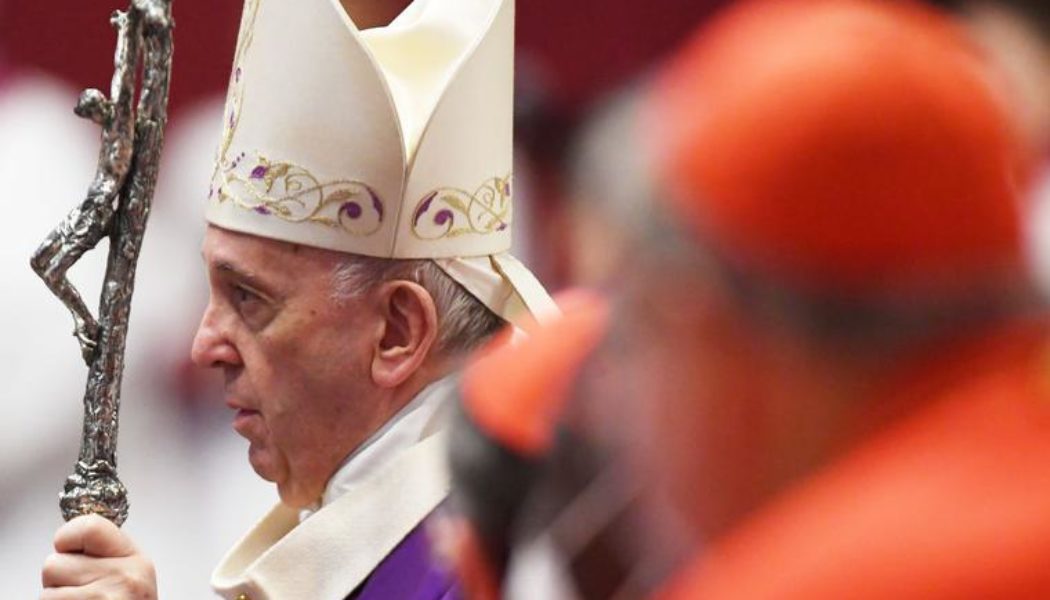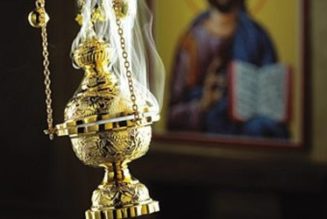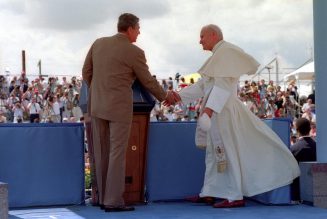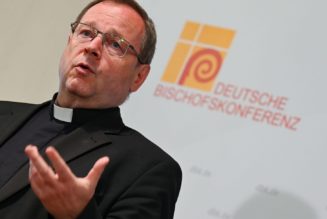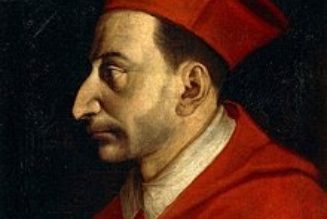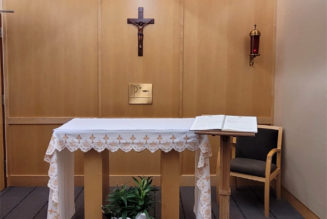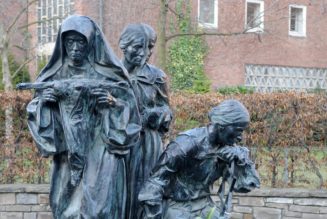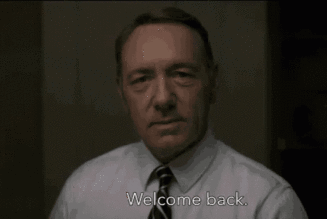
SAN DIEGO — When reporters asked Cardinal-designate Robert McElroy of San Diego to explain why Pope Francis passed over two California-based metropolitan archbishops to give him the red biretta, his explanation was simple and uncomplicated.
“Pope Francis has a series of initiatives that he’s trying to bring to the life of the Church,” said the San Diego bishop, during a May 31 press conference, “and I have tried to take those initiatives and plant them here.”
The cardinal-designate went on to explain that he embraced Francis’ teaching on the promotion of environmental justice, care for migrants and “a more pastoral orientation rather than a strict doctrinal orientation within the life of the Church.”
When Pope Francis announced May 29 the creation of 16 new cardinal-electors, who will receive their red hats at an Aug. 27 consistory at the Vatican, the list held a number of surprises, including the appointment of the San Diego prelate, a progressive voice in the U.S. Conference of Catholic Bishops who has repeatedly clashed with its leadership on the priority given to abortion, and, more recently, attacked Archbishop Salvatore Cordileone of San Francisco’s decision to bar House Speaker Nancy Pelosi from receiving the Eucharist in his archdiocese until she repudiates her public advocacy of abortion rights.
Prominent Sees Excluded
Likewise, Francis’ list featured Church leaders unknown to most Vatican watchers, thus underscoring his preference for deeply personal choices designed to bring voices from the margins into the center of the Church.
“My elevation as a cardinal is certainly a reiteration of the attempt of the Pope to reach out to the peripheries,” Cardinal-designate Anthony Poola, 60, of Hyderabad, India, who will be the first Dalit to elect a pope, told the Register in an interview marking his appointment.
Church leaders from once-prominent sees in Milan, Venice, Krakow, Paris and Los Angeles did not make the list. Instead, Francis honored cardinal-designates based in Marseille, France, and Cuomo, Italy, as well as Mongolia, East Timor and Singapore.
The news may have taken some Catholics unawares, but Church experts who have studied Francis’ approach to the creation of cardinals and noted how he has departed from the practices of his two immediate predecessors are not surprised.
“You can see a very personal signature when it comes to Pope Francis’ appointment of cardinals,” said Msgr. Martin Schlag, a professor of Catholic social thought at the University of St. Thomas in Minnesota. He became familiar with Francis’ priorities and process of spiritual discernment while serving as a consultant for the Pontifical Council for Justice and Peace in Rome. Francis’ approach arises from a desire to create a “Church of the poor,” Msgr. Schlag told the Register.
By contrast, “John Paul and Benedict’s appointments were more institutional,” and their appointments were thus more likely to be “linked to a traditional metropolitan see. You would name the archbishop of Vienna, not the auxiliary bishop.”
The reason for this past practice, Msgr. Schlag added, was that the “archbishops who lead the largest groups of Catholics in the world should somehow represent those voices in … the election of the pope. It was less a question of ‘Who do I like personally?’ or ‘Who do I think is most holy?’”
Break With Practice
Francis’ latest appointments have stirred debate in the United States, as theologians and commentators weigh the degree to which the Church’s first Latin American pope has broken with once-established practices by ignoring two sitting metropolitan archbishops — one of whom, Archbishop José Gomez of Los Angeles, is the elected president of the USCCB and represents the largest diocese in the nation — while singling out a progressive bishop who has strongly backed his initiatives.
Some argue that John Paul and Benedict adopted a similar approach, one that both sidelined prelates challenging their agendas and maintained the Church’s power center in the West.
But the record reveals that their legacy is more nuanced.
“Like it or not, St. John Paul clearly gave red hats to people who were not in sync with his views,” Russell Shaw, the author of Eight Popes and the Crisis of Modernity, told the Register.
The Polish Pontiff’s early appointment of Cardinal Agostino Casaroli, the architect of Ostpolitik, the Vatican’s Cold War policy governing relations with the Soviet Union and the satellite nations that John Paul strongly opposed, was “a good example,” said Shaw. The appointment of Cardinal Carlo Maria Martini of Milan, a liberal icon, was another.
John Paul and Benedict’s biographers echo Shaw’s view that both pontiffs created cardinals who did not always agree with their agenda.
“The Italian Church valued Martini, and John Paul II did not believe in insulting local episcopates by denying red hats to prominent and popular members of that episcopate,” George Weigel, the author of two biographies on the late pontiff, told the Register. “John Paul also may have hoped that pastoral experience would modify the views of Carlo Maria Martini, who had been an academic until his appointment to Milan. That didn’t quite work out.”
Indeed, John Paul has received considerable criticism for his mixed record in this area, as some of his choices provided lackluster leadership, while others failed to challenge a culture of abuse and cover-up at the highest levels of the Church. In particular, Catholic reformers and clergy-abuse survivors have called out the appointment of Theodore McCarrick as an egregious failure to heed warnings about his alleged sexual misconduct from whistleblowers and U.S. Church leaders like Cardinal John O’Connor of New York.
At the same time, while Pope Francis is often credited with creating a College of Cardinals less focused on the concerns and priorities of the Church in the West, that effort actually took root more than two decades earlier, during John Paul’s pontificate.
In conformity with the teaching of Popes John XXIII and Paul VI and the Second Vatican Council, the College of Cardinals took on a more expansive role and was no longer seen as the “presbyterium of the Diocese of Rome,” said Opus Dei Father Philip Goyret, professor of ecclesiology at the Pontifical University of the Holy Cross in Rome. And as a result, the “collegiality of the episcopate” and the demands of a global Church steadily gained importance.
“John Paul II appointed 231 new cardinals from 69 different countries,” Father Goyret told the Register, noting that 17 countries had a cardinal for the first time.
Weigel, for his part, suggested that John Paul’s appointment of cardinals from Africa and other parts of the developing world was also motivated by a strategic vision.
“John Paul II wanted the College of Cardinals to reflect the vitality of the Church in the developing world, which he hoped would give heart and energy to members of the college from the ‘Old World,’” said Weigel.
Benedict’s Approach
Pope Benedict XVI, by contrast, faced criticism for stalling that trend. In February 2012, he created 22 new cardinals, 16 of whom were European. After those appointments were challenged, he called a mini-consistory later that year and added six non-Europeans to the number of 114 cardinal-electors.
In an electrifying homily before the 2005 conclave, then-Cardinal Joseph Ratzinger had warned of a “dictatorship of relativism” in the West and urged the cardinal-electors to confront the challenge head-on. After his election, Benedict XVI gave red hats to Archbishops Raymond Burke and Robert Sarah, but he also stumbled in his effort to create cardinals capable of fulfilling this task.
“Benedict XVI certainly … appointed cardinals who did not correspond to his ideas in everything,” acknowledged Peter Seewald, the author of a sweeping two-volume biography of the German Pope.
“The appointment of cardinals is a political issue; there were always certain compromises. Certainly, he made cardinals of bishops who later were not at all in his line, like Cardinal Reinhard Marx of Munich and Freising,” who would support the blessing of same-sex unions and reception of Communion for the divorced-and-civilly remarried in specific cases.
And there were other prelates, said Seewald, who “ended up being very weak shepherds. All in all, his personnel policy was not always happy.”
Paul Badde, a Rome-based historian and journalist, made a similar point as he considered Benedict’s appointments of German cardinals, some of whom have backed the German “Synodal Path,” a gathering of prelates and lay leaders who have pressed for major changes to Catholic doctrine on priestly celibacy, women’s ordination and homosexual unions, raising alarm in the Vatican.
By contrast, sources contacted for this story viewed Pope Francis’ vetting of leading prelates as more hard-nosed and perhaps too “one-sided,” at times, but also deeply reliant on his practice of Ignatian spiritual discernment.
“In my opinion, the appointments of this pontificate are more ‘one-sided’ (naturally, in the side of the Pope),” said Father Goyret.
“In the previous pontificates, there was a certain sense of appointing new cardinals of different ‘wings,’ so as to guarantee a real debate in a future conclave.”
That specific goal may help explain John Paul’s appointment of respected German prelates and priest-theologians, like Cardinal Walter Kasper, who called for Communion for the divorced-and-civilly remarried back in the 1990s but was still created a cardinal in 2001 and tapped to serve a nine-year term as president of the Pontifical Council for Promoting Christian Unity.
Different Objectives
But it can be difficult to pin down each pope’s full intentions in such matters. For example, was the creation of the first cardinal of Mongolia, a country bordering China with about 1,500 Catholics, a sign of Francis’ concern for a struggling local Church, as some have argued, or a strategic move to shore up the Church’s presence in the region, as a Reuters news report concluded?
Msgr. Schlag, for his part, suggested Catholics should adopt a different framework when comparing the appointments of John Paul and Benedict with those of Francis and the specific goals they represented.
The two previous pontiffs “had the ecclesial task of bringing clarity to the Church’s teaching,” he noted. “Where we had experienced the development of doctrine, they clarified the doctrine.”
Now that Catholics have received that clarity, he said, Francis wants to “go back to the original intention of the Council, with the hermeneutics of evangelization.”
“If we judge Francis with the same hermeneutics of reform that we expected from John Paul and Benedict, we will be disappointed. That is the big key to understanding Francis. There has been a paradigm shift,” he said.
That insight helps explain why many Catholics are perplexed by this pontificate’s approach to sensitive issues, like outreach to “LGBT” Catholics, and thus turn to his appointments to the College of Cardinals to confirm his theological orientation.
Jesuit Father Allan Figueroa Deck, who served with Bishop McElroy on the board of directors of the Jesuit School of Theology of Santa Clara University, told Religion News Service that the San Diego bishop’s appointment showed that the Pope was not only concerned with bringing Church leaders from the geographical peripheries into the center of the Church, but also prelates who were less preoccupied with doctrinal concerns of recent popes. The bishop’s inclusive pastoral approach to Catholics who identify as “LGBTQ” and pro-abortion politicians who presented themselves for Communion mirrored the Pope’s own views, Father Deck argued.
“It’s not a change in morality,” said Father Deck. “It’s a change in how we reach out and how we seek for ways to accompany people, even when they aren’t always living up to ideals that we propose for our faith.”
However, Larry Chapp, a retired professor of theology at DeSales University, took a more critical view of the appointment’s significance.
Francis, Chapp charged in a June 2 commentary for Catholic World Report, “is attempting to subvert the theological hermeneutic of the previous two papacies: Pope John Paul II’s, in particular, and primarily in the realm of the late Pontiff’s moral theology.”
Chapp pointed to Bishop McElroy’s “unabashed” support for Francis’ controversial 2016 apostolic exhortation, Amoris Laetitia, and the form of moral theology that undergirds it. He explained that the “proportionalism” found in Amoris teaches “that there can be no absolute moral norms since moral actions are largely determined, not by the moral object of the act itself or the teleology of the faculty in question (classic natural-law principles), but by the concrete circumstances in the life of the person committing the act.”
Pope John Paul II addressed the dangers of proportionalism in Veritatis Splendor.
The San Diego bishop’s elevation to the College of Cardinals, Chapp concluded, “is the Pope’s way of signaling that McElroy’s approach to the moral theological principles of Amoris is correct.”
But if the majority of Catholic theologians are focused on the deeper meaning of these appointments, some have also considered the doctrinal impact of the new cohort of cardinals from the developing world, who have spent little or no time in Rome and whose theological positions are unknown.
Most analysts agree that the “significant” influence of African cardinals has checked progressive forces in the College of Cardinals, and that could also be the case as greater numbers of Asian prelates take up their duties.
The Next Conclave
But how, ask Vatican watchers, will these new cardinals exercise their responsibility to elect Francis’ successor if they have not studied in Rome, served on Vatican congregations or rubbed elbows with the papabili among them? John Paul II grappled with that same conundrum. And he convoked several consistories that provided opportunities for consultation on vital decisions facing the universal Church, while offering newcomers a chance to assess emerging leaders.
Today, Francis’ creation of cardinals from far-flung places like Mongolia also “creates a real problem for the next papal-election conclave,” said Russell Shaw. “Partly to remedy that, I imagine, and as long-range preparation for the conclave, Pope Francis has called a consistory of the College of Cardinals — the first in seven years.”
After the Aug. 27 consistory, where the new cardinals will receive their red hats, the full College of Cardinals will meet to discuss the apostolic constitution Praedicate Evangelium, which sets forth the restructuring of the offices of the Roman Curia.
“Call it a consistory if you like,” said Shaw, “but I am thinking of it as [the] ecclesial equivalent of the national conventions at which the Democrats and Republicans choose their presidential candidates.”
Msgr. Schlag agreed that Francis needs to find solutions that will keep cardinals on the geographic margins up to speed with the full College of Cardinals.
“Maybe this will lead to a change in the way the conclaves are held,” he said. “What I wouldn’t like is for … American, Italian or German cardinals who have resources to visit Myanmar collecting votes. These are new challenges.”
Join Our Telegram Group : Salvation & Prosperity
